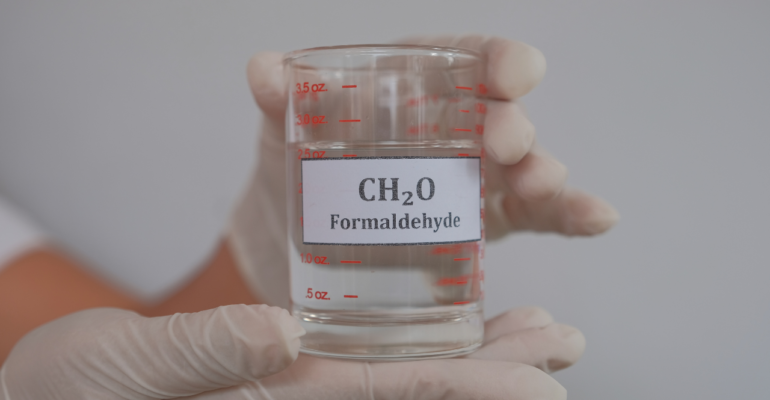Formaldehyde- Source, Uses, Side Effects & Avoidance Measure
October 3, 2020 2025-04-21 7:46Formaldehyde- Source, Uses, Side Effects & Avoidance Measure
As an Amazon associate, Dermatocare earns from valid purchase made by clicking on the affiliate links in this blog.

Formaldehyde- Source, Uses, Side Effects & Avoidance Measure
Introduction
Formaldehyde is a chemical widely used across industries as a preservative, disinfectant, and cross-linking agent. While its most recognized use is in embalming practices for preserving biological specimens, formaldehyde and its derivatives are also commonly found in cosmetics and personal care products. Although permitted in regulated concentrations, its presence raises concerns due to potential irritant, allergenic, and carcinogenic properties, especially with long-term or repeated exposure.
Health Risks Associated with Formaldehyde
Occupational exposure to high levels of formaldehyde, especially through inhalation, has been linked to certain cancers, including nasopharyngeal carcinoma and leukemia, as per the International Agency for Research on Cancer (IARC).
In the context of cosmetic use, formaldehyde exposure is significantly lower. However, even at low levels, it may cause:
- Allergic contact dermatitis
- Skin irritation, especially in individuals with sensitive or atopic skin
- Respiratory irritation, particularly in poorly ventilated environments
- Potential interference with DNA repair mechanisms in skin cells, as suggested by emerging laboratory studies
While dermal exposure has not been conclusively linked to skin cancer, one observational study reported a higher prevalence of skin cancer in mortuary workers, possibly due to chronic exposure to formaldehyde vapors.
Common Sources of Formaldehyde Exposure
According to the National Cancer Institute, formaldehyde exposure may occur from the following:
1. Household Sources
- Pressed wood products such as particleboard and plywood
- Cigarette smoke
- Unvented gas stoves, kerosene heaters, and wood-burning stoves
2. Occupational Settings
- Mortuaries and laboratories
- Textile, chemical, and construction industries
3. Cosmetic Products
In cosmetics, formaldehyde is rarely added as a raw ingredient. Instead, formaldehyde-releasing preservatives are used. These slowly release formaldehyde when exposed to water and are primarily employed to inhibit microbial growth and extend product shelf life.
Common formaldehyde-releasing agents include:
- DMDM Hydantoin
- Imidazolidinyl Urea
- Diazolidinyl Urea
- Quaternium-15
- Bronopol (2-bromo-2-nitropropane-1,3-diol)
- Tris(hydroxymethyl) nitromethane
- Sodium Hydroxymethylglycinate
These compounds are often found in shampoos, body lotions, moisturizers, liquid soaps, and baby care products.
Regulatory Guidelines and Industry Response
- The European Union and Cosmetic Ingredient Review (CIR) restrict free formaldehyde content in cosmetic products to no more than 0.2% (2,000 ppm).
- The FDA allows its use but does not mandate explicit labeling unless formaldehyde is directly added.
- Johnson & Johnson has announced the removal of formaldehyde-releasing agents from all baby products in response to public concern.
How to reduce exposure?
- Avoid formaldehyde-releasing preservatives, especially if you have:
- Sensitive, eczema-prone, or allergic skin
- A personal or family history of skin cancer
- Infants or elderly individuals using the product
- Read ingredient labels carefully, particularly for leave-on products.
- Opt for products using safer preservatives, such as:
- Sodium benzoate
- Potassium sorbate
- Phenoxyethanol
- Ensure good indoor ventilation and consider using air purifiers and dehumidifiers to reduce ambient exposure at home.
Conclusion
Although permitted within defined safety limits, formaldehyde and its releasing agents pose a potential risk, especially for individuals with compromised skin barriers or underlying sensitivities. From a dermatological perspective, it is prudent to avoid cosmetics and personal care products containing these compounds when possible. Safer alternatives are readily available and should be preferred for both daily skincare and long-term health.
At Dermatocare, we classify formaldehyde-releasing preservatives under toxic ingredients and advise our users to avoid them in both skincare formulations and environmental sources.
ROUTINE FINDER
Get free dermatologist-recommended regime by choosing your skin or concerns.

FACE

HAIRS

CHILD

BODY




